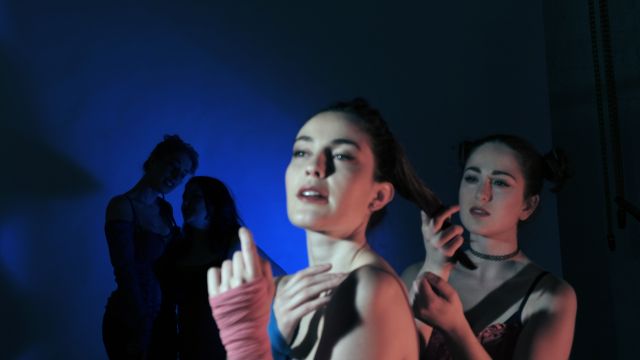The Masque of Beauty
The Masque of Beauty really is a ‘masque’ – i.e. not a ‘play’. Or at least, it is masque-like. The performers wear no masks, instead opting for elaborate make-up. Nor does it conclude with traditional celebratory images of beauty and concord in homage to whoever is in power. On the contrary. La Mama’s quarterly handbook of coming attractions calls it a ‘renaissance cabaret’.
It’s a bawdy, ironic, cynical affair performed by Maria Paula Afanador (as the infamous Lucrezia Borgia), Madeleine Field, Claire Nichols and Jessica Greenwald. (While the program notes name the characters, it does not tell us who plays which.) Lucrezia is paired (so to speak) with her brother Cesare. They necessarily must plot against Isabella D’Este, the Marchese of Mantua. There’s also Elisabetta Gonzaga, Duchese di Urbino – and, briefly, La Giaconda, the Mona Lisa herself – who has one of the best jokes of the show… The characters rarely exchange dialogue, but when they do it’s couched as deliberately anachronistic modern chat. Most of the time, the women declaim to the audience about their vulnerable positions, the necessity of beauty, together with their fear of syphilis, their hopes and ambitions and the wiles they must employ to achieve them. Their movements, on a narrow platform stage, are formal (at least in intention) and choreographed to form a series of tableaux. The excellent music, by Faye Bendrups, who also directs, and Guillermo Anad on viola, has an appropriately stately baroque feel.
Clearly conceived by Peter Green out of a love of Italian history and language and, indeed, the now archaic forms of courtly entertainment – against which he juxtaposes the more sordid facts of (real) life. His masque is a light-hearted account of the rivalries and intrigues of the Italian female nobility in the late 15th and early 16th century Italy – a kind of poeticised history romp from a feminist (but ‘women beware women’!) point of view.
Unfortunately, various aspects reduce things. On a banal level, the stage – a sort of catwalk – creaks and squeaks with every heavy footstep so that spoken and sung words are lost. (Didn’t anyone notice this?) The costumes, featuring bustiers, shorts, striped stockings and hectic colour combinations, lower the tone, but I’m not sure to exactly what. The performers seems under-rehearsed (they probably are) and under-confident and their movements tentative. Ms Afanador, certainly an elegant beauty, has an accent that is charming but impenetrable while the other voices rather lack the very necessary royal conviction and, more seriously, clarity.
This is a disappointing show in that its intentions are, in retrospect, quite clear, but the realisation – or the execution - falls short. Taking the mickey out of these near-mythic Italian noblewomen would have more oomph, more irony and more fun were the mickey-taking delivered with more grace, more style and a non-creaking stage.
Michael Brindley
Subscribe to our E-Newsletter, buy our latest print edition or find a Performing Arts book at Book Nook.

